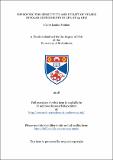Improving the sensitivity and utility of pulsed dipolar experiments in EPR at 94 GHz
Abstract
Pulsed dipolar spectroscopy (PDS) is an electron paramagnetic resonance (EPR) technique,
used to conduct long range distance measurements in proteins in the nanometre range. This
thesis presents a number of methodological and instrumental techniques to improve the sensitivity and utility of PDS experiments using a home-built high power pulsed spectrometer,
HiPER, operating at 94 GHz. These include the implementation of phase-modulated composite pulses, which correct for imperfections arising due to inhomogeneity, and offer increased
excitation bandwidth as well as experimental protocols such as annealing and glassing of samples. A theoretical study into the use of matched filtering to reduce echo noise during measurements, has predicted gains of up to a factor of 3 enhancement in signal-to-noise.
Using such techniques we demonstrate sensitivity enhancements of more than 30 on PDS
experiments, between nitroxides and Fe centres, in haem-proteins, corresponding to a reduction in averaging time of almost 1,000, in comparison to standard commercial spectrometers
operating at X-band. The use of composite pulses in PDS experiments on nitroxide biradicals
were also investigated, including their limitations due to intramolecular effects. The thesis
then describes a single frequency dipolar modulation experiment, RIDME, and uses high field
measurements to determine both the distance and relative orientation of a cobalt-nitroxide
system, for the first time. Finally, a design study is conducted to implement frequency and
amplitude modulated pulses on a spectrometer at 9/34 GHz to improve sensitivity.
Type
Thesis, PhD Doctor of Philosophy
Collections
Items in the St Andrews Research Repository are protected by copyright, with all rights reserved, unless otherwise indicated.

